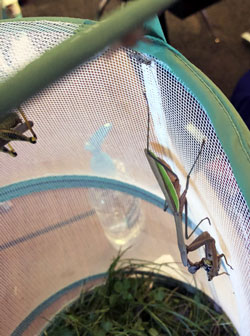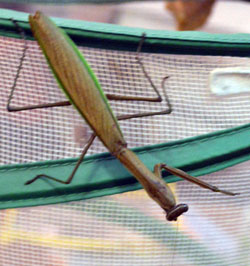There’s a fascinating creature in teacher Kate Hull’s classroom. She has a triangular head with bulging eyes and an enormous appetite. She moves at lightning speed and eats grasshoppers like tasty morsels.
Meet Francis the Mantis — fierce hunter. Agile acrobat. Writer’s muse. Bad girlfriend.

Not only is the other-worldly-looking praying mantis, which students found in the schoolyard, providing entertainment in the West Elementary classroom; she is teaching students a thing or two about curiosities in the natural world and fierce animal instincts, the fourth graders explained.
From inside her habitat of leaves, dirt, sticks and grass, Francis has inspired much scientific study, research papers, and lots of conversation.
While she mostly eats other bugs, praying mantises can take down animals three times her size, students learned. “They can eat birds, frogs, lizards, snakes and each other,” said Kalayla Kome.
In a research paper, Julianna Mosher detailed the insect’s habitat, eggs and diet. “They live in warmer regions and prefer hotter places. Most species can be found in the tropical rainforest,” she wrote.
Also, the class shared, Francis can turn her head 180 degrees and has one ultrasonic ear on her chest.
But perhaps most gruesomely, “When they mate, the female eats the male,” said Cody Stacy.

Schoolyard Visitor
A few weeks ago, while outside for recess, students discovered Francis hanging out on the side of the school building. They ran to tell Hull, who said, “Go get it!”
Julianna’s mother brought in a butterfly habitat, and the students got busy learning what Francis needed to survive. They built a dwelling perfect for a mantis. They watched her eat — often, and voraciously — and soon noticed her trim abdomen begin to bulge.
“We started to wonder, maybe this isn’t a male,” Hull said.
Sure enough, the next Monday morning an egg sac called an ootheca hung on the side of the cage.
Students are also learning about the circle of life. Francis will soon die, which is nature’s way of protecting her eggs from the always hungry mother, said Hull.
In eight to 10 weeks the eggs should hatch, though Hull’s unsure if she will keep them in the class. The babies are so tiny, she said, they could crawl out of the habitat’s netting.
She’s loved seeing the students learn about Francis step by step, from discovery to research to catching food and feeding her, to observing and writing about her.
“It was the most impromptu learning lesson I’ve had in years,” Hull said. “It’s been amazing.”











